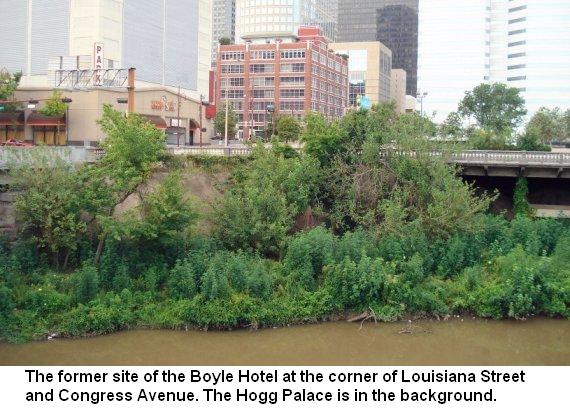In the wharf area, Water Street may have been the roadway used to move goods and cargo between the warehouses along Commerce Avenue and the boats docked at the wharf. Beyond the wharf area, there seems to have been little use for the Water Street right of way, especially as the city came to learn of the fluctuation of the bayou's water level. Development along what was designated as Water Street was subject to frequent flooding. One exception to that idea occurred in the unplatted right of way between Louisiana Street and Smith Street at Congress Avenue.
The Borden plat of Houston of January 18, 1837 shows three gullies entering Buffalo Bayou from Louisiana Street to Smith Street. This topography probably indicates a low bank in this area that was unsuitable for general development. Yet, by 1869, there was one small structure on one lot near the northwest corner of Louisiana Street and Congress Avenue. By 1885, the site contains two frame dwellings.
Associated businesses occupied store fronts along Congress Avenue and Louisiana Street. The saloon and billiard parlor served a clientele in much the same way that such places do today. The establishments held similar dangers for its customers. For example, On December 18, 1892, A. Allen, the son of black legislator Richard Allen was accidentally shot at 11 am in the bar room of the "negro dance house and variety theater" at the end of Louisiana Street. His wounds were serious, but not fatal. Guns, bars and billiards were a dangerous mixture even then. And, at 11 o'clock in the morning! Contemporary news accounts referred to the place as the "honka tonk" and it seems it may not be much different from venues of a similar description today.
The owner of the building, Frank Dunn, suffered the loss of the structure valued at $5,000 and the furnishings of $2,000, all of which were uninsured. The African American proprietor of the theater, R. L. Andrews, had a similar uninsured loss of $2,000 for the fixtures. The property, however, did not remain vacant for long. Situated near the downtown business district and adjacent to Grand Central Station, it was a good location for the hotel built by the Boyle family on the site later in 1894.
W. T. Boyle came to Houston from Dallas in 1894 with his wife and his three grown sons, and the three men were the proprietors of the Hotel Boyle. After the unexpected death of son Charles in 1896, W. T. Boyle and his son J. T. Boyle continued to operate the hotel. They were successful enough in this venture that they were able to acquire the former Hutchins House, a prestigious old hotel that had fallen into some disrepair. On March 1, 1897, the Boyle family sold their interest in the Hotel Boyle and took over the management of the Hutchins House. Unfortunately for the Boyle family, the Hutchins House was destroyed by a pre-dawn fire on October 19, 1901.
The Hotel Boyle continued to operate under the proprietorship of F. D. Burke. But, the hotel had its problems, too. Fire, caused by an explosion of gasoline, broke out in the hotel in 1908. Mrs. Burke, the wife of the proprietor, leapt fifty feet from the hotel roof to escape the flames that engulfed the building. Mrs. Burke landed amid logs, stumps and timber behind the building. The fall knocked her unconscious and she sustained internal injuries. The hotel was repaired and continued in business for another twenty years.
 The final episode for the Boyle Hotel came in
1928. By this time the hotel was owned by the city and managed by R. W.
Green. Three city offices were located in the lobby. About 3:15 am on
December 11, 1928, the Boyle Hotel caught fire. Manager Green awakened
the 30 to 35 guests, and some of them escaped by jumping out back
windows into Buffalo Bayou. Sadly, three men died in the fire. The two
story, brick Hotel Boyle was destroyed.
The final episode for the Boyle Hotel came in
1928. By this time the hotel was owned by the city and managed by R. W.
Green. Three city offices were located in the lobby. About 3:15 am on
December 11, 1928, the Boyle Hotel caught fire. Manager Green awakened
the 30 to 35 guests, and some of them escaped by jumping out back
windows into Buffalo Bayou. Sadly, three men died in the fire. The two
story, brick Hotel Boyle was destroyed. This site on the banks of Buffalo Bayou was never intended for development by the Allen brothers. Subsequent construction on the site ended in failure and tragedy. No new structures were built there after the 1928 fire. The channelization of the bayou during this same time made the tract of land unsuitable for use. The site today is home only to trees, riparian vegetation and stray trash. No sign of its prior history can be seen. Yet, it should be remembered.